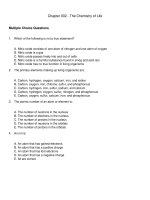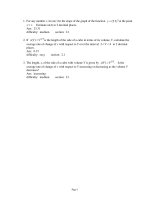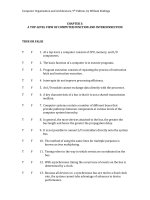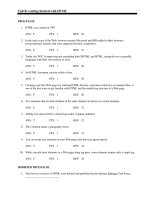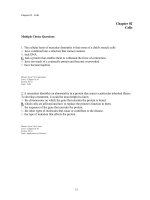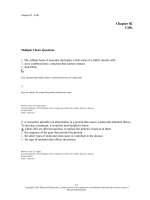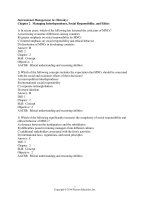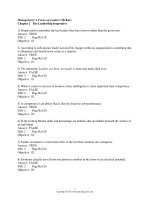Objective c and iOS programming a simplified approach to developing apps for the apple iphone and ipad 1st edition arshia khan test bank
Bạn đang xem bản rút gọn của tài liệu. Xem và tải ngay bản đầy đủ của tài liệu tại đây (202.12 KB, 8 trang )
Chapter 2: Data Types and Arithmetic Expressions
TRUE/FALSE
1. Data can take many forms, including numbers, individual alphabetic characters, strings of alphabetic
characters, and numbers with specific decimal precision.
ANS: T
PTS: 1
REF: 16
2. NSLog provides an extended set of functionality for outputting information such as the option to
format data.
ANS: T
PTS: 1
REF: 16
3. NSLog takes at least two string parameters.
ANS: F
PTS: 1
REF: 16
4. The \n in the NSLog statement:
NSLog(@"Please enter a number\n");
is a number specifier.
ANS: F
PTS: 1
REF: 17
5. In the Objective-C statement:
scanf("%d", &num);
&num is the name of a variable in which a number will be stored.
ANS: T
PTS: 1
REF: 17
6. The Objective-C int data type is used to store a whole number that does not have a decimal point.
ANS: T
PTS: 1
REF: 18
7. The Objective-C char data type is used to store strings of characters.
ANS: F
PTS: 1
REF: 19
8. The Objective-C float data type is used to store real numbers.
ANS: T
PTS: 1
REF: 20
9. In the expression:
int *prtValue = &value;
the & symbol before the variable named value gives its address location.
ANS: T
PTS: 1
REF: 21
10. The Objective-C id data type is typically used to point to an object of an unknown data type.
ANS: T
PTS: 1
REF: 23
11. The struct functionality in Objective-C allows a programmer to define a new data type with
enumerations.
ANS: F
PTS: 1
REF: 24
12. In Objective-C, the values assigned to enumerations are of integer type.
ANS: T
PTS: 1
REF: 25
13. In the Objective-C statement:
typedef enum {Jan, Feb, March, April, May} Month;
the value of April is 4.
ANS: F
PTS: 1
REF: 25
14. The #define statement in Objective-C is an example of a preprocessor.
ANS: T
PTS: 1
REF: 26
15. An advantage of using constants in a program is that, if the value of the constant needs to be changed,
the programmer only needs to change it in one location rather than searching the entire program and
modifying every instance.
ANS: T
PTS: 1
REF: 26
16. Expressions that contain operands and operators are called arithmetic expressions.
ANS: T
PTS: 1
REF: 26
17. If the Objective-C operator div is used with integers and there is a nonzero remainder, it will round
up or down to the nearest integer.
ANS: F
PTS: 1
REF: 27
18. You can use either pre or post increment notation for increment operations since the results are always
the same.
ANS: F
PTS: 1
REF: 30
19. The Objective-C pre increment operator will first evaluate the expression and then perform the
increment after the expression is evaluated.
ANS: F
PTS: 1
REF: 30
20. The Objective-C subtract and assign operator, -=, first subtracts a value from a variable and then
assigns this new value to the variable.
ANS: T
PTS: 1
REF: 32
MULTIPLE CHOICE
1. To store data, a program requires placeholders. A ____ placeholder holds data that changes as the
program runs.
a. constant
b. variable
ANS: B
c. string
d. concatenated
PTS: 1
REF: 16
2. Data types help the Objective-C language ____ allocate memory for storage.
a. compiler
c. memory manager
b. interpreter
d. programmer
ANS: A
PTS: 1
REF: 16
3. In Objective-C, concatenation is the process of combining multiple ____ into a single element.
a. addresses
c. variables
b. numbers
d. strings
ANS: D
PTS: 1
REF: 16
4. ____ is identified by Apple as an error log mechanism used to output data to the console.
a. Scanf
c. NSLog
b. NSError
d. NSOutput
ANS: C
PTS: 1
REF: 16
5. The NSLog function uses ____ specifiers which are tokens that start with the symbol %, followed by a
character that specifies a data type.
a. data-type
c. foundation
b. format
d. parameter
ANS: B
PTS: 1
REF: 16
6. NSLog takes one or more parameters in the form of a string with format specifiers. The string with the
format specifier starts with the ____ symbol.
a. %
c. &
b. @
d. #
ANS: B
PTS: 1
7. ____ reads input typed by the user.
a. Read
b. Readline
ANS: D
PTS: 1
8. In the Objective-C statement:
scanf(“%f, &num);
the variable num has a type of ____.
a. decimal
b. real
ANS: D
PTS: 1
REF: 16
c. Getf
d. Scanf
REF: 17
c. integer
d. float
REF: 17
9. When using the scanf method in code that requires the user to enter data that will be stored as a
double, you should use the format specifier ____.
a. %n
c. %f
b. %ld
d. %lf
ANS: D
PTS: 1
REF: 18
10. The data type ____ is used to store a whole number that does not have a decimal point.
a. char
c. float
b. int
d. double
ANS: B
PTS: 1
REF: 18
11. The ____ data type is used to store a single character.
a. int
c. character
b. char
d. string
ANS: B
PTS: 1
REF: 19
12. The storage space utilized by an Objective-C float is ____ bits.
a. 8
c. 64
b. 32
d. 128
ANS: B
PTS: 1
REF: 20
13. The storage space utilized by an Objective-C double is ____ bits.
a. 8
c. 64
b. 32
d. 128
ANS: C
PTS: 1
REF: 20
14. Various combinations of basic data types can be used to create more complex data types. What are
these data types called?
a. complex
c. derived
b. combined
d. double
ANS: C
PTS: 1
REF: 21
15. The ____ type holds a memory location where data is stored.
a. pointer
c. main
b. id
d. struct
ANS: A
PTS: 1
REF: 21
16. In Objective-C code, a variable of type ____ is created by using the * symbol.
a. char
c. pointer
b. struct
d. id
ANS: C
PTS: 1
REF: 21
17. ____ a pointer means extracting the value the pointer is pointing to.
a. Dereferencing
c. Releasing
b. Extracting
d. Deriving
ANS: A
PTS: 1
REF: 21
18. The Objective-C NSLog format specifier for a pointer variable is ____.
a. %d
c. %n
b. %v
d. %p
ANS: D
PTS: 1
19. Given the following code segment:
REF: 22
int num = 5;
int * ptrValue;
ptrValue = #
where the memory address holding num is 0x7fff6506989c, the output from the statement
NSLog(@”%d”,*ptrValue) is ____.
a. 5
c. num
b. 0x7fff6506989c
d. 5 0x7ff6506989c
ANS: A
PTS: 1
REF: 22
20. The ____ type is a generic data type that stores data of any type.
a. id
c. pointer
b. struct
d. gen
ANS: A
PTS: 1
REF: 23
21. The ____ type is a combination of several data types that creates a new custom data type. It is a
remnant of the original C language, before object oriented programming was introduced.
a. id
c. pointer
b. struct
d. gen
ANS: B
PTS: 1
REF: 23
22. Given the following Objective-C code segment:
struct ball
{
int num;
float size;
char color;
};
struct ball b;
which of the following statements would set the value of the property num of the newly created
variable to 5?
a. ball.num = 5;
c. struct.ball = 5;
b. b.num = 5;
d. struct.b = 5;
ANS: B
PTS: 1
REF: 23
23. ____ notation is used to populate and retrieve the values of variables in a structure.
a. Char
c. Dot
b. Struct
d. #
ANS: C
PTS: 1
REF: 24
24. In Objective-C, the term ____ means a defined range of values for a variable.
a. itemization
c. list
b. enumeration
d. inventory
ANS: B
PTS: 1
REF: 24
25. In the following section of code, the programmer did not specify the value that should be associated
with each month.
typedef enum {
Jan,
Feb,
March,
April,
May,
} Month;
By default, the first month, Jan, will be assigned the value ____.
a. 0
b. 1
ANS: A
c. %undefined
d. %error
PTS: 1
REF: 25
26. The ____ in Objective-C is a special tool that helps you create custom statements.
a. debugger
c. importer
b. compiler
d. preprocessor
ANS: D
PTS: 1
REF: 26
27. The Objective-C ____ statement is used to define constants and associate them with unique names.
a. #const
c. #define
b. #preprocess
d. #customize
ANS: C
PTS: 1
REF: 26
28. Objective-C arithmetic operators can be divided into basic and ____ assignment operators.
a. compound
c. modulus
b. complex
d. enumerated
ANS: A
PTS: 1
REF: 26
29. The character % represents the Objective-C basic assignment operator ____.
a. percent
c. assign
b. modulus
d. divide
ANS: B
PTS: 1
REF: 26
30. Given that the integer num1 = 24 and the integer num2 = 15, the value of the variable div in the
expression:
div = num1 / num2
is ____.
a. 0
c. 1
b. .625
d. 1.6
ANS: C
PTS: 1
REF: 27
31. The modulus operator returns the ____ after division.
a. divisor
c. remainder
b. dividend
d. quotient
ANS: C
PTS: 1
REF: 28
32. The Objective-C modulus operator only works on ____.
a. real numbers
b. floats
ANS: D
c. doubles
d. integers
PTS: 1
REF: 29
33. To produce the output, 7 % 2, in Objective-C, you could use the statement:
NSLog(@”7 ____ 2”).
a. %
c. ”%”
b. ’%’
d. %%
ANS: D
PTS: 1
REF: 29
34. The Objective-C operator ____ means increment by 1.
a. +=
c. +/
b. ++
d. =+
ANS: B
PTS: 1
REF: 30
35. If x = 5, the expression ++x*2 evaluates to ____.
a. 5
c. 11
b. 10
d. 12
ANS: D
PTS: 1
REF: 30
36. If x = 5, the expression x++*2 evaluates to ____.
a. 5
c. 11
b. 10
d. 12
ANS: C
PTS: 1
37. The operator += is called a ____ operator.
a. conjunctive
b. compound
ANS: B
PTS: 1
REF: 30
c. complex
d. pre increment
REF: 32
38. If num1 = 2 and num2 = 3, the value of num1 after evaluating the expression
num1 += num2
will be ____.
a. 2
c. 5
b. 3
d. 7
ANS: C
PTS: 1
REF: 32
39. A shorthand method for writing the expression num1 = num1 * num2 is ____.
a. num1 *= num2
c. num1 ++* num2
b. num1 *++ num2
d. num1 == num2
ANS: A
PTS: 1
REF: 33
40. If num1 = 6 and num2 = 4, after evaluating the expression
num1 %= num2
the value of num1 is ____.
a. 2
c. 6
b. 4
d. 10
ANS: A
PTS: 1
REF: 34
